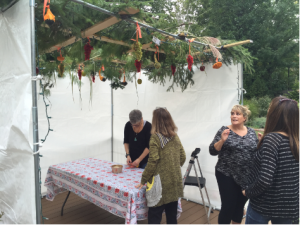 We are about to begin the holiday of Sukkot. From My Jewish Learning, this is an overview of the holiday:
We are about to begin the holiday of Sukkot. From My Jewish Learning, this is an overview of the holiday:
Beginning five days after Yom Kippur, Sukkot is named after the booths or huts (sukkot in Hebrew) in which Jews are supposed to dwell during this week-long celebration. According to rabbinic tradition, these flimsy sukkot represent the huts where the Israelites dwelt during their 40 years of wandering in the desert after escaping from slavery in Egypt. The festival of Sukkot is one of the three great pilgrimage festivals (chaggim or regalim) of the Jewish year.
Here is the link to the full article: https://www.myjewishlearning.com/article/sukkot-101/
By using the Sukkah, we glimpse the experience of our vulnerability.
And this moment of vulnerability requires us to think of those held captive. We pray for and demand the release of the hostages.
We are told to eat at least one meal in the Sukkah. On a lovely fall evening, you can see the stars through the Skach, covering the top. But on cold or rainy evenings, it is another entirely different experience, and we certainly get the message of being vulnerable! (By the way, our great sage, Maimonides, suggests strongly that when it’s rainy, go inside!)
One of the interesting aspects of “dwelling in the Sukkah” is the ritual of inviting the Ushpizin. These are our revered forebears with whom we’d love to talk and glean some of their wisdom. It started with Abraham, Isaac, Jacob, Joseph, Moses, Aaron, and King David. It is extended to include the great matriarchs Sarah, Miriam, Deborah, Hannah, Abigail, Huldah, and Esther. And it is a chance to broaden the guest list even further. I have invited loved ones, particularly my great-grandfather. Who is on your guest list?
